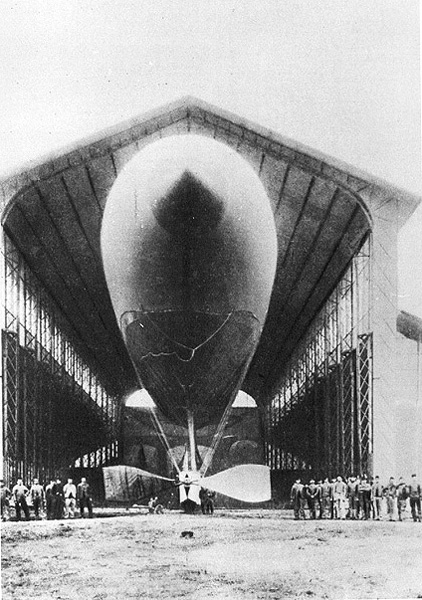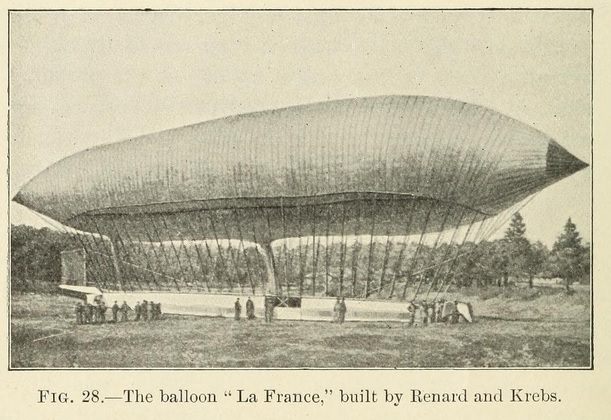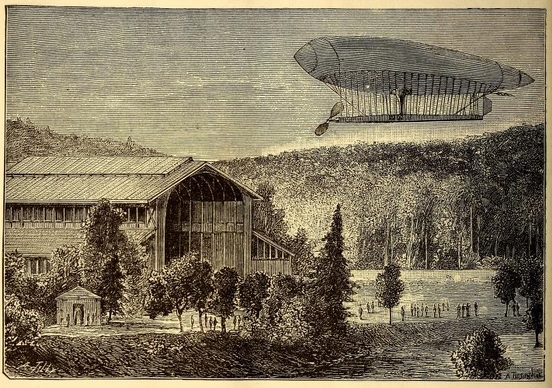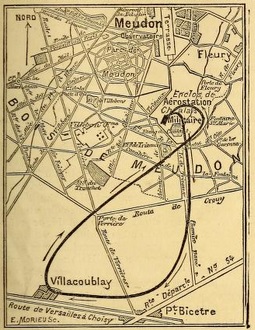

In the words of the Air-Midshipman's Primer Song:
Vive La France! Let us extol
Her electric-powered flight.
Here was lift, here was control,
Aviation was in sight.

The new steering apparatus for balloons invented by the two French officers of engineers, Capt. Renard and Capt. Krebs, is attracting considerable attention in warlike Europe. The experiments, for which Gambetta during his short lease of power obtained a grant of 100,000 francs, have been conducted for six years past in the forest of Meudon with the greatest secrecy. The two officers have admittedly been guided in their studies by the earlier labors of Mr. Dupuy de Lôme in 1870-72.
The conditions laid down by the inventors themselves were:

Capt. Renard undertook the more strictly scientific part of the work, and Capt. Krebs the rest. The former invented the new electric pile of exceptional lightness and power; and the latter constructed the screw and the rudder, and the apparatus for the electric motor.
The balloon is formed in the shape of a cigar, pointed at both extremities; a net hangs from it, containing seats for two aëronauts, a directing apparatus, and a rudder. It is stated that the force is obtained by a series of electric accumulators of ten horse-power, which may be operative during four hours.

Of their first trip, the inventors made the following report : ---
On Aug. 9, at four p.m., with the wind almost calm, the aërostat, with little ascensional power, rose slowly to the height of the surrounding uplands. The machine was put in motion; and soon the aërostat increased its speed, obeying the slightest movement of its rudder.

The route was first held north and south, toward Châtillon and Verrières, above the road from Choisy to Versailles; and, in order not to become entangled among the trees, the direction was changed to Versailles. Above Villacoublay, we were about four kilometres from Chalais; and, perfectly satisfied with the behavior of the balloon, we decided to return and to descend at Chalais, notwithstanding the narrow space allowed by the trees. The balloon was successfully turned to the right, the rudder making a small angle (about eleven degrees). The diameter of the circle described was about three hundred metres; the dome of the Invalides, taken as the point of direction, was a little to the right of Chalais. After arriving above this point, the balloon was easily turned to the left; and soon it was hovering three hundred metres above its point of departure. It was necessary to work the machine backward and forward, in order to bring the balloon above the place chosen for the descent. At thirty metres above the ground, a rope dropped from the balloon was seized, and the aërostat was brought, down in the very meadow whence it had set off.
Several times during the trip, the balloon underwent oscillations of from two to three degrees, resembling pitching; these oscillations were attributed either to irregularities in the shape, or to currents of local air rising vertically.
The balloon is 50.42 metres long, and 8.40 metres in diameter. The course taken was 7.6 kilometres long, and was finished in twenty-three minutes.
